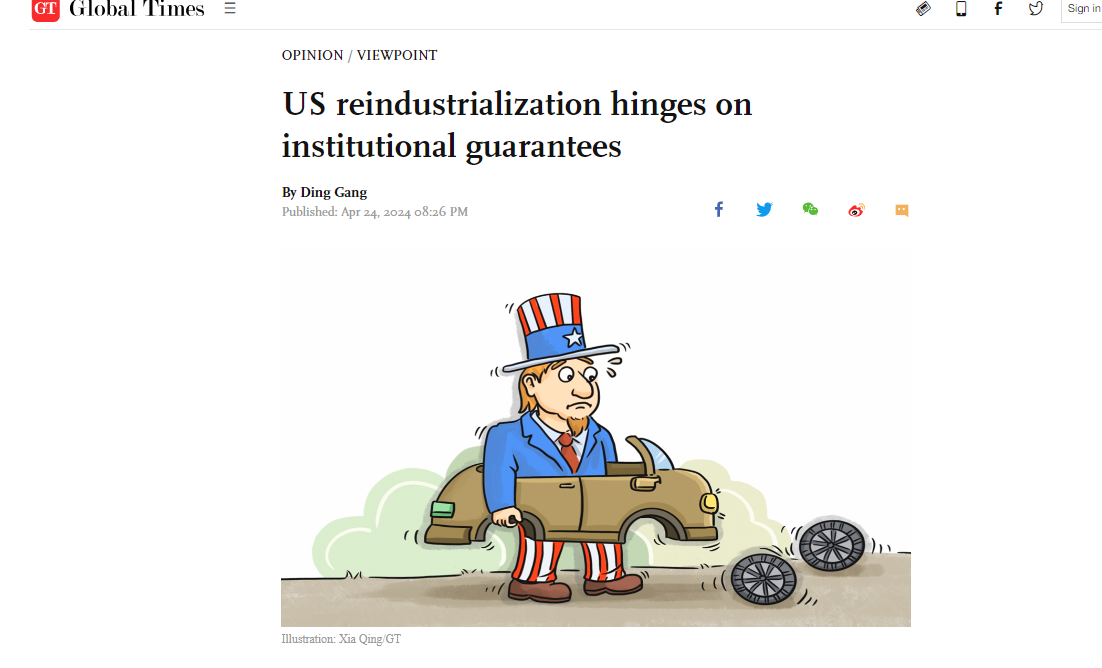LATEST INSIGHTS
Your Present Location: LATEST INSIGHTSDing Gang: US reindustrialization hinges on institutional guarantees
Source: Global Times Published: 2024-04-24

The US is finally going to have its first true high-speed railroad. On Monday, construction began on the Brightline West, connecting Las Vegas and Southern California. The railroad will be a private, all-electric, high-speed rail line, 218 miles (350 kilometers) long, with trains running at a speed of 200 miles per hour. It is expected?to take four years to build.
Today, the total length of China's operating high-speed railroads has reached 45,000 kilometers. Some Americans may argue that they do not need such extensive high-speed rail systems. However, the narrative surrounding the infrastructure embodied by high-speed rail is not that simple.
While the US is relentlessly attacking Chinese manufacturing for 'overcapacity,' this high-speed railroad reflects the gap in infrastructure between the US and China. As the US loses its competitiveness, it can do nothing else but raise the flag of trade protectionism.
The New York Times published a report on US-China industrial policies titled 'Chinese Exports Are Threatening Biden's Industrial Agenda' on April 18. The report conveyed that the Chinese government has heavily invested in the green industry, including offering attractive loans from state-run banks to companies that might not have survived otherwise, to help offset a real estate crisis and sluggish domestic consumption. It claimed that these Chinese factories often operate with low-cost labor, making it impossible for the US to compete.
This perspective is common in the West and represents a severe misinterpretation of China's economic development, leading to a strategic misdirection in Washington's national strategy for competing with China.
In recent years, the Joe Biden administration has emphasized the need to maintain the US' dominance in high technology, especially in the semiconductor field. It is taking extreme measures to curb China's advancement in chip technology, as if by doing so the US can suppress China in the mid-to-low end of manufacturing forever.
Even though the Biden administration has expressed a commitment to prioritize infrastructure development and has allocated a huge amount of funds for it, infrastructure construction is still progressing at a slow pace.
However, relying solely on high-tech leadership is not sufficient for reindustrialization and, in the long run, cannot compete with Chinese manufacturing.
Why is the pace and scale of Chinese manufacturing expanding globally? It has accumulated enough momentum to reach a breakthrough stage. This is not about industrial overcapacity but a comprehensive industrial upgrade and full support from an advanced infrastructure system that challenges Western manufacturing capabilities.
A key misunderstanding by the US and Europe lies in their failure to connect Made-in-China with China's rapid infrastructure development.
The Chinese successful approach includes highly efficient logistics, the convergence of main product systems, the spread of networks from cities to every corner of the country, the rapid advancement of EV technology and the presence of charging posts everywhere, all of which are ultimately related to infrastructure.
Reindustrialization cannot be achieved solely with a few advanced chips and AI technology; ultimately, AI development depends on sufficient electricity generation. This is one of the reasons why the US cannot maintain its major industries without being impacted by protectionism alone.
I question whether the policies and strategies devised against China truly grasp the current situation in China or involve any on-site investigations. They likely rely on speculation from office reports. American officials seldom reference China's 'Five-Year Plans,' which are integral to China's infrastructure success, when discussing competition with China.
Of course, Washington realizes that even if it had a plan to develop infrastructure as vigorously as China, it might not be feasible to implement it without any system reform.
Recently, a bridge in Baltimore, Maryland, was damaged, and experts have debated whether repairs could take two, five, or even 10 years. We shall see.
Let me tell you a story from 10 years ago. In 2015, Beijing had a complete main beam replacement project at Sanyuan Bridge, one of the busiest and biggest sections in the city, which had been in service for 40 years. The project took only 43 hours from start to finish.
Undoubtedly, if Washington truly wants to achieve reindustrialization, the fundamental issue is not about money. The US is wealthy, it has the funds. It ultimately comes back to how to ensure faster improvement of infrastructure through institutional guarantees.
The author is a senior editor with People's Daily, and currently a senior fellow with the Chongyang Institute for Financial Studies at Renmin University of China. dinggang@globaltimes.com.cn. Follow him on X @dinggangchina
Key Words: Ding Gang, US reindustrialization























































































 京公网安备 11010802037854号
京公网安备 11010802037854号





